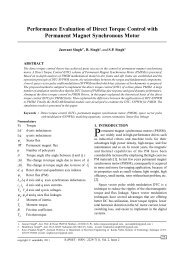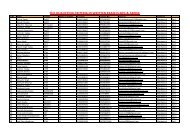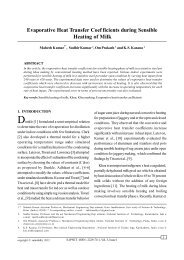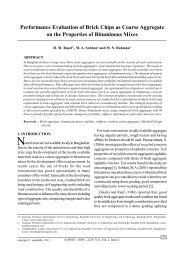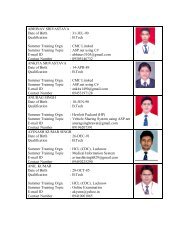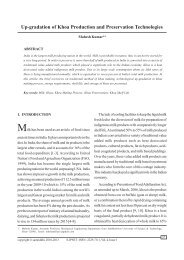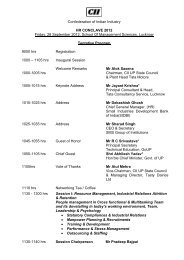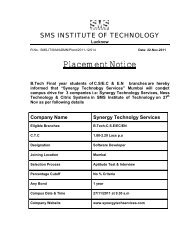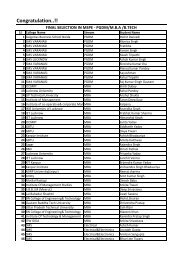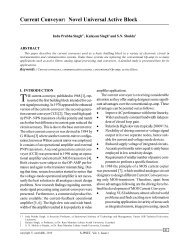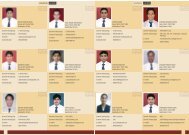Electronics Spectra - SMS Lucknow
Electronics Spectra - SMS Lucknow
Electronics Spectra - SMS Lucknow
You also want an ePaper? Increase the reach of your titles
YUMPU automatically turns print PDFs into web optimized ePapers that Google loves.
<strong>SMS</strong> Institute of Technology, L ucknow<br />
Ground Penetrating Radar (GPR)<br />
INTRODUCTION<br />
AS we know landmines are very<br />
harmful for us. Landmines and<br />
unexploded ordnance (UXO) are a<br />
legacy of war, civil disobedience and<br />
guerilla activity. If all mines were cased<br />
or had substantial metallic content, all<br />
that would be required for det ection<br />
are metal detectors. The widespread<br />
use of plastic landmines necessitates<br />
development and deployment of additional<br />
detection technologie s. Because<br />
there is no such thing as a plastic<br />
detector, other sensors at tempt<br />
to exploit ancillary disturbances in the<br />
background, such as thermal, chemical,<br />
or dielectric.<br />
OVERVIEW OF THE<br />
SYSTEM<br />
Because of the difficulty dete cting<br />
the tiny amounts of metal in a plastic<br />
landmine with a metal dete ctor,<br />
technology development has bee n<br />
funded in other areas. Ground penetrating<br />
radar (GPR) has been used<br />
for nearly 70 years for a variety of geophysical<br />
subsurface imaging applications<br />
including utility mapping and hazardous<br />
waste container location and<br />
has been actively applied to the problem<br />
of landmine detection for nearly<br />
20 years. When parameters such as<br />
frequency range, antenna size, antenna<br />
separation and system ti ming<br />
are optimized for detection of minesized<br />
objects in the near subsurface,<br />
GPR is quite effective in dete cting<br />
both metal and plastic landmines in a<br />
variety of soils. The depth of penetration<br />
is a function of both the frequency<br />
range produced and the soil<br />
attenuation.<br />
Lower frequency components<br />
penetrate further but it is a higherfrequency<br />
component that is ne cessary<br />
to image and resolve smaller targets.<br />
Both impulse- based and swept<br />
frequency GPR systems have bee n<br />
employed in Army-sponsored research<br />
programs. Generally a system with a<br />
bandwidth of roughly 1 to 4GHz is<br />
effective for detection of landmines.<br />
Ultimately GPR images the dielectric<br />
properties of the soils a nd any<br />
discontinuities appear as a signal. If soil<br />
were perfectly homogeneous, a discontinuity<br />
caused by a land mi ne<br />
Screen shot of host software f rom GEO-CENTERS<br />
would stand out as an anomaly against<br />
the background. Unfortunately, even<br />
under near-ideal test track conditions,<br />
soil itself is a remarkably in homogeneous<br />
medium and false alarms are<br />
easily generated from the background<br />
itself. Because of this, automatic target<br />
recognition (ATR) algorithms employed<br />
by impulse-based GPR systems<br />
typically calculate and remove background<br />
and try to detect the h yperbolic<br />
signatures that are characteristic<br />
in size and shape of landmine targets<br />
in GEO-CENTERS 400 Series energy<br />
in focusing ground penetr ating<br />
radar (EFGPR), we employ a fuz zy<br />
logic-based algorithm that use prototypes,<br />
or feature sets, for landmines<br />
and prototypes than to clutter.<br />
HOW IT WORKS?<br />
An FR-127-MSCB impulse ground<br />
penetrating radar (ImGPR) syst em<br />
developed by the Commonwealth<br />
Scientific and Industrial Research Organization<br />
(CSIRO), Australia, has been<br />
used for these measurements. T he<br />
system collects 127 returns or surroundings,<br />
per second each composed<br />
of 512 samples with 12 bit acc uracy.<br />
The sounding range may vary from 4<br />
ns to 32ns. The GPR system uses<br />
bistatic bow-tie antennas which transmit<br />
wideband ultrashort durati on<br />
pulses.<br />
The measurements form a two<br />
dimensional matrix referred to as a<br />
radargram or B scan and A scan are<br />
used for visual inspection of data on<br />
Department of <strong>Electronics</strong> & Co mmunication<br />
B SCAN<br />
Priyanka Shukla<br />
EC - III year<br />
the acquisition computer<br />
and in laboratory<br />
analysis.<br />
A SCAN<br />
A scan is a method<br />
for detecting the presence<br />
and absence of<br />
surrogate mine in clay<br />
soil. The electromagnetic<br />
field is scattered<br />
by the GPR. Scattering<br />
pulses are detecting by<br />
the graph. This graph<br />
is Amplitude Vs Time.<br />
This graph is helpful to<br />
find the landmine and<br />
is used for visual inspection.<br />
B scan is a graph which is Tim e<br />
delay Vs Distance. So B scan helps to<br />
calculate the penetration length. This<br />
graph helps to calculate the distance<br />
from ground to the mine.<br />
ADVANTAGES<br />
‣ GPR locates even small targets.<br />
‣ GPR operates by detecting the<br />
dielectric soils which allows it to<br />
locate even no metallic mines.<br />
‣ Biological sensors can only operate<br />
for limited periods but in GPR<br />
has no such limits.<br />
‣ GPR has been tested in different<br />
environmental conditions.<br />
DISADVANTAGES<br />
‣ The sensor such as GPR is larger<br />
and heavier.<br />
‣ GPR is more power hungry.<br />
‣ GPR can suffer falls alarm rates as<br />
high as metal detectors.<br />
<br />
41 <strong>Electronics</strong> <strong>Spectra</strong>, 2010



